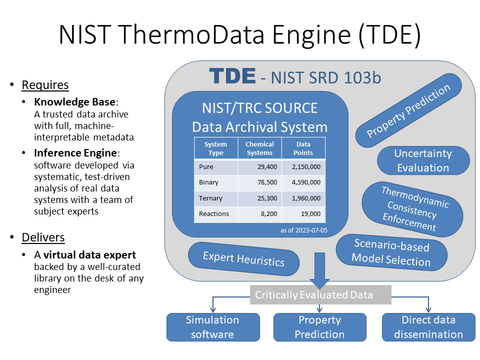NIST Standard Reference Database 103b
NIST ThermoData Engine Version 10.4.5 - Pure Compounds, Binary Mixtures and Reactions
Price: $9090.00 PLACE ORDER
Price: $1000.00 - Upgrade from version 10.x PLACE ORDER
Price: $5000.00 - Upgrade from version 5.x-9.x PLACE ORDER
PURPOSE:
The purpose of ThermoData Engine (TDE) is to provide critically evaluated thermodynamic and transport property data using SOURCE– a dynamically curated data archival system established at NIST. The critical evaluation is based on:
- published experimental data,
- predicted values derived from molecular structure,
- user supplied data (optional).
ThermoData Engine is the first product fully implementing all major principles of the concept of dynamic data evaluation formulated at NIST/TRC. This concept follows the model of an expert system, requiring a large electronic database capable of storing essentially all 'raw' experimental data known to date with detailed descriptions of relevant metadata and uncertainties. An inference engine combines these data with state-of-the-art property prediction schemes and heuristics that emulate the critical evaluation process of a domain expert. Combined in one package, TDE generates recommended data compilations automatically 'to order'. The NIST/TRC SOURCE data archival system, currently containing approximately 8.7 million experimental data points, is used in conjunction with ThermoData Engine as a comprehensive storage facility for experimental thermophysical and thermochemical property data. Currently, this database contains property data for approximately 29,000 pure compounds, 79,000 binary mixtures, 25,000 ternary mixtures, and 8,200 chemical reactions.

SCOPE:
System types:
- pure organic and common inorganic compounds,
- binary mixtures containing organic and common inorganic compounds,
- ternary mixtures containing organic and common inorganic compounds.
Supported phase states:
- gas,
- liquid,
- fluid,
- crystal (different types),
- glass,
- multiphase systems.
Property groups (about 120 properties total):
- Thermophysical/thermodynamic properties for pure compounds and mixtures: densities, vapor pressures, heat capacities, critical properties, melting and boiling points, enthalpies of phase transitions, sound speed, surface tension, refractive index, etc.
- Phase equilibrium data for mixtures: vapor-liquid, liquid-liquid, solid-liquid, solid-vapor, etc.
- Transport properties: viscosities, thermal conductivities, electrical conductivity, diffusion coefficients, etc.
- Properties of reactions: enthalpies, entropies, equilibrium constants, Gibbs energies.
FEATURES:
- The NIST/TRC SOURCE archive contains well-structured up-to-date information from major current and historical publications on thermophysical properties of organic and common inorganic compounds.
- Full provenance on all experimental and estimated data that underpin critical recommendations is provided.
- Proprietary data can be entered for inclusion in the evaluation, and the user can influence the evaluation process by changing relative data weights or by rejecting particular data sets.
- The TDE software incorporates all major stages of the data evaluation concept, including data retrieval, grouping, normalization, sorting, consistency enforcement, fitting, and prediction for all major thermophysical properties. The TDE fills the gaps in experimental data by the deployment of property prediction, enforces of consistency between related properties (including those obtained from predictions), provides for flexibility in selection of default data models depending on the particular data scenario, incorporates a large variety of models for secondary fitting, and allows saving of critically evaluated data in the ThermoML format.
- TDE supports:
- several equations of state for pure compounds (original and modified volume-translated Peng-Robinson, Sanchez-Lacombe, PC-SAFT, and Span-Wagner) and allows user to fit their parameters to experimental and predicted data;
- access to REFPROP for supported pure compounds;
- access to experimental single-phase thermodynamic, thermophysical, and transport property data, VLE, LLE, and SLE data from the NIST/TRC SOURCE data archive, and automated evaluation of most of those properties;
- special fitting equations for certain properties such as densities, critical, and transport properties;
- phase equilibria data to be described by activity coefficient models selected by the user from the set of supported models: Margules, NRTL, Redlich-Kister, UNIQUAC, van Laar, and Wilson. UNIFAC predictions are generated for mixtures covered by the various versions of the UNIFAC method, including NIST-modified UNIFAC model as well as with COSMO-SAC predictive model;
- phase diagrams, isotherms, and isobars based on those models to be calculated and drawn for the user's convenience;
- on-demand comparison with isomers and other compounds of interest as well as automatic generation of compounds families based on the group decomposition schemas (NIST-modified UNIFAC, Joback, Benson, etc.).
- TDE can evaluate thermophysical properties and their uncertainties for multi-component material streams.
- The stored experimental data include calorimetric and/or reaction-equilibrium data for about 8,200 reactions.
- Enthalpies of formation are evaluated on the basis of stored experimental enthalpies of combustion, high-level quantum chemical calculations, and modified Benson group-contribution method.
- TDE provides functionality for determination of chemical systems possessing required ranges of thermophysical properties to support the user’s activities in chemical product design, including solvent design for dissolution and extraction. TDE also implements an algorithmic approach to aid users in experiment planning based on the accumulated body of knowledge stored in the NIST/TRC SOURCE archive as well as from the TDE prediction models.
- ThermoML output assures compatibility of the ThermoData Engine with any engineering application equipped with a ThermoML software 'reader'.
You may browse the Users' Guide to see how this database works.
System Requirements: PC with Microsoft® Windows® XP, Windows Vista, Windows 7, Windows Server 2003, Windows Server 2008, or Windows Server 2012. At least 2 GBytes of memory is recommended.
For more information please contact:
Standard Reference Data Program
National Institute of Standards and Technology
100 Bureau Dr. Stop 6410
Gaithersburg, MD 20899-6410
(844) 374-0183 (Toll Free)
The scientific contact for the database is:
Chris Muzny, Ph.D
Thermodynamics Research Center (TRC)
NIST Applied Chemicals and Materials Division
325 Broadway Mailcode 647.01
Boulder, CO 80305-3337
303-497-5549 chris.muzny [at] nist.gov (Chris[dot]Muzny[at]nist[dot]gov)
Keywords: thermodynamics; experimental data; data retrieval; grouping; normalization; sorting; consistency enforcement; fitting; prediction; thermophysical; thermochemical; ThermoML; Thermodynamics Research Center
data [at] nist.gov (Customer Support)

